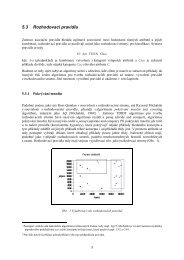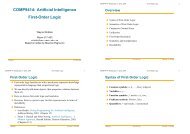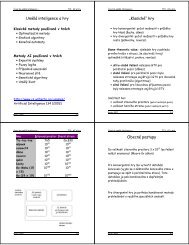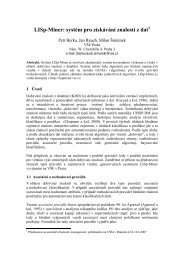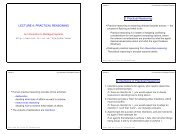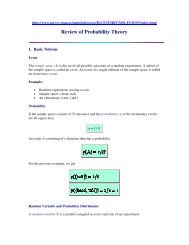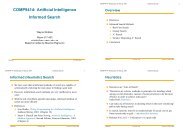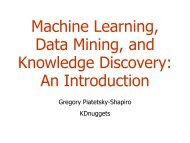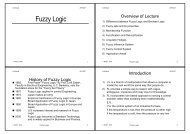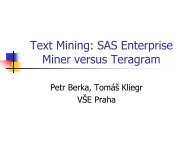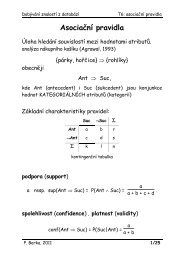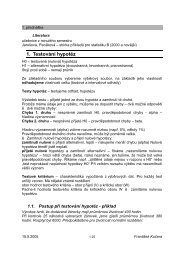COMP9414: Artificial Intelligence Knowledge Representation ... - Sorry
COMP9414: Artificial Intelligence Knowledge Representation ... - Sorry
COMP9414: Artificial Intelligence Knowledge Representation ... - Sorry
Create successful ePaper yourself
Turn your PDF publications into a flip-book with our unique Google optimized e-Paper software.
<strong>COMP9414</strong>, Wednesday 6 April, 2005 <strong>Knowledge</strong> <strong>Representation</strong> and Reasoning 12<br />
<strong>COMP9414</strong>, Wednesday 6 April, 2005 <strong>Knowledge</strong> <strong>Representation</strong> and Reasoning 14<br />
Semantics<br />
Terminology<br />
The semantics of the connectives can be given by truth tables<br />
P Q ¬P P ∧ Q P ∨ Q P → Q P ↔ Q<br />
True True False True True True True<br />
True False False False True False False<br />
False True True False True True False<br />
False False True False False True True<br />
One row for each possible assignment of True/False to propositional<br />
variables<br />
A sentence is valid if it is True under all possible assignments of<br />
True/False to its propositional variables (e.g. P ∨ ¬P)<br />
Valid sentences are also referred to as tautologies<br />
A sentence is satisfiable if and only if there is some assignment of<br />
True/False to its propositional variables for which the sentence is<br />
True<br />
A sentence is unsatisfiable if and only if it is not satisfiable (e.g.<br />
P ∧ ¬P)<br />
Important: Above P and Q can be any sentence, including complex<br />
sentences<br />
<strong>COMP9414</strong> c○UNSW, 2005 Generated: 7 April 2005<br />
<strong>COMP9414</strong> c○UNSW, 2005 Generated: 7 April 2005<br />
<strong>COMP9414</strong>, Wednesday 6 April, 2005 <strong>Knowledge</strong> <strong>Representation</strong> and Reasoning 13<br />
<strong>COMP9414</strong>, Wednesday 6 April, 2005 <strong>Knowledge</strong> <strong>Representation</strong> and Reasoning 15<br />
Semantics — Complex Sentences<br />
Material Implication<br />
R S ¬R R ∧ S ¬R ∨ S (R ∧ S) → (¬R ∨ S)<br />
True True False True True True<br />
True False False False False True<br />
False True True False True True<br />
False False True False True True<br />
The only time P → Q evaluates to False is when P is True and Q is<br />
False (i.e. P → Q is equivalent to ¬P ∨ Q)<br />
This is known as material implication<br />
English usage often suggests a causal connection between antecedent<br />
(P) and consequent (Q) – this is not reflected in the truth table<br />
So (P ∧ ¬P) → anything is a tautology!<br />
<strong>COMP9414</strong> c○UNSW, 2005 Generated: 7 April 2005<br />
<strong>COMP9414</strong> c○UNSW, 2005 Generated: 7 April 2005



